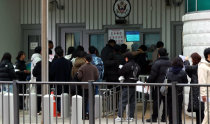Leaders of 48 Nations to Visit St. Petersburg for 10 Days
Leaders of 48 Nations to Visit St. Petersburg for 10 Days
Posted May. 23, 2003 22:14,
A large scale festival began yesterday to celebrate the 300th anniversary (May 27) of Saint Petersburg, the city of white nights.
Top leaders from 48 nations plan to visit St. Petersburg during the 10 day festival, causing people all over the world to look at the city, the former capital city of imperial Russia with renewed interest.
Mayor Vladimir Yakovlev and Sergei Mironov, Chairman of the Federation Council, attended at the opening ceremony of the festival held in the Ice Palace (an ice-rink). President Vladimir Putin whose birthplace was Saint Petersburg, sent Valentina Matvienko, the presidents plenipotentiary of northwest Russia.
Putin will have a series of summit talks in St. Petersburg with Chinese President Hu Jintao on May 27, Japanese Prime Minister Junichiro Koizumi on May 31, and US President George W. Bush on June 1.
The summit of the Commonwealth of Independent States and the summit between Russia and the European Union will be held on May 30 and 31 respectively and leaders of 40 nations will gather together for a dinner.
The festival will end on June 1 but unofficial celebratory events will continue throughout the year; 2700 small and large scale academic conferences and events related to literature and art will also be held.
August 11~17 has been announced as Korean Week in Russia, so President Rho Moo-hyun is considering delaying his visit to Russia so that he can be there for Korean Week. He also plans to change the location of his summit meeting from Moscow to St. Petersburg.
St. Petersburg was built by Peter the Great in 1703. He built the city on a marsh at the mouth of the Neva River in an attempt to westernize Russia. It was the capital city of imperial Russia for 200 years and was also the city where the Russian Revolution started in 1917.
The Soviet Union moved its capital to Moscow and changed the name of St. Petersburg to Leningrad (the city of Lenin) after Vladimir Lenin. However, the city renamed itself after the USSR`s collapse in 1989.
The whole city is often called a museum as the city has a great number of cultural and historical assets such as the Hermitage Museum, considered one of the top three museums in the world with its collection of 2.5 million works of art and the Mariinsky Theatre, the origin of ballet. In addition, the city consists of about 70 rivers and canals and about 100 islands with around 600 bridges. St. Petersburg is often referred as the City of Water or Venezia of the North.
Ki-Hyun Kim kimkihy@donga.com




![화장실 갇혔을 때 생존법…“최후에는 변기뚜껑” [알쓸톡]](https://dimg.donga.com/c/138/175/90/1/wps/NEWS/IMAGE/2025/12/26/133042007.3.png)


